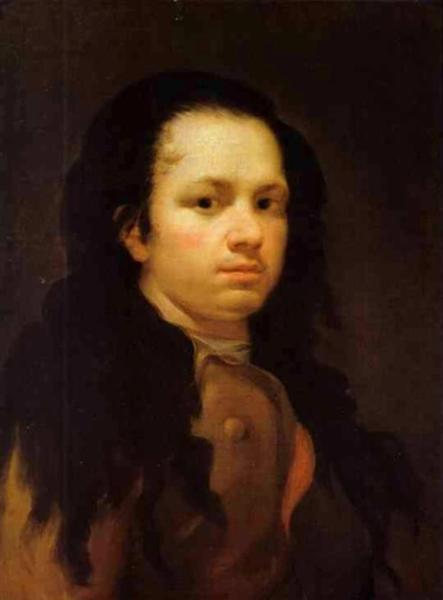Description
Francisco Goya's 1775 self-portrait is a work that, although it may seem simple at first glance, offers multiple layers of meaning and a profound reflection of the artist's character at a crucial moment in his life. Goya, one of the greatest masters of Romanticism and a precursor of modern art, has in this work a visual testimony of his artistic maturity and the self-recognition that would accompany him throughout his career.
In the self-portrait, Goya presents himself with a direct and penetrating gaze, appealing to the emotional connection with the viewer. His face, slightly illuminated and enlivened by a subtle tone of flesh, displays a series of traits that are frequently associated with his personality: introspective, energetic and reflective. The expression that the artist adopts is intense, with the eyes as a focal point that seem to scrutinize the essence of the viewer, while the mouth, with a slight curve, suggests both a serene confidence and an underlying melancholy.
Goya has opted for a dark background that contrasts with the luminosity of her figure, further accentuating her presence. This compositional choice is characteristic of many portraits of the period, where the subject becomes the most prominent figure, standing out from the context. This technique of isolation also suggests a sense of inner isolation, something that would become a recurring theme in his work later on. The use of black and dark tones reinforces the atmosphere of introspection, while the flash of light on her face evokes hope and possibility.
The palette used by Goya in this self-portrait is subtle, predominantly composed of browns, ochres and beiges, revealing his mastery of the chiaroscuro technique, a skill he had cultivated during his classical training. This mastery of colour not only establishes volume, but also lends an almost tangible quality to the artist’s skin. Each fold and shadow becomes an expression of his lived experience, his own story made flesh. Furthermore, the skillful use of the brush adds a texture that seems to ooze life, giving the viewer the feeling that the painting could come into motion at any moment.
It is relevant to note that the self-portrait can also be seen as a reflection on the role of the artist in the society of his time. In the context of the 18th century, Goya found himself at a crossroads where tradition and modernity began to coexist. With this work, Goya was not only representing himself, but also placing himself as a protagonist in the history of art, questioning what it meant to be a painter in a time of political and social change. The connection with the viewer, the introspection and the use of a controlled palette, in a world that was beginning to falter, presented him as a pioneer who was not afraid to address the rawest truths of human nature.
Throughout his career, Goya continued to explore his own identity through various self-portraits, each revealing different facets of his artistic and personal being. The self-portrait of 1775, however, stands as a milestone in his development, manifesting not only his technical mastery, but also a deep understanding of his role as a creator in an age that yearned for transformation.
In short, the 1775 self-portrait is more than just a representation of the artist; it is a work that captures the essence of a vital moment in Goya's life and in the history of art. Through its penetrating gaze, subtle hues, and carefully balanced composition, the viewer is invited to contemplate the complexity of the human being, a theme that Goya would explore in depth throughout his career.
KUADROS ©, a famous painting on your wall.
Hand-made oil painting reproductions, with the quality of professional artists and the distinctive seal of KUADROS ©.
Painting reproduction service with satisfaction guarantee. If you are not completely satisfied with the replica of your painting, we will refund 100% of your money.

